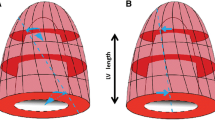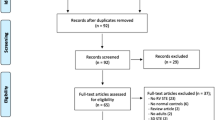Abstract
Purpose
To describe the mechanics and possible clinical importance of left ventricular (LV) rotation, exemplify techniques to quantify LV rotation and illustrate the temporal relationship of cardiac pressures, electrocardiogram and LV rotation.
Materials and methods
Review of the literature combined with selected examples of echocardiographic measurements.
Results
Rotation of the left ventricle around its longitudinal axis is an important but thus far neglected aspect of the cardiac cycle. LV rotation during systole maximizes intracavitary pressures, increases stroke volume, and minimizes myocardial oxygen demand. Shearing and restoring forces accumulated during systolic twisting are released during early diastole and result in diastolic LV untwisting or recoil promoting early LV filling. LV twist and untwist are disturbed in a number of cardiac diseases and can be influenced by several therapeutic interventions by altering preload, afterload, contractility, heart rate, and/or sympathetic tone.
Conclusions
The concept of LV twisting and untwisting closely linking LV systolic and diastolic function may carry potential diagnostic and therapeutic importance for the management of critically ill patients. Future clinical studies need to address the feasibility of assessing LV twist and untwist as well as the relevance of its therapeutic modulation in critically ill patients.



Similar content being viewed by others
References
Burns AT, McDonald IG, Thomas JD, Maclsaac A, Prior D (2008) Doin’ the twist: new tools for an old concept of myocardial function. Heart 94:978–983. doi:10.1136/hrt.2007.120410
Sengupta PP, Tajik AJ, Chandrasekaran K, Khandheria BK (2008) Twist mechanics of the left ventricle—principles and application. JACC Cardiovasc Imaging 1:366–376. doi:10.1016/j.jcmg.2008.02.006
Esch BT, Warburton DER (2009) Left ventricular torsion and recoil: implications for exercise performance and cardiovascular disease. J Appl Physiol 206:362–369. doi:10.1152/japplphysiol.00144.2008
Streeter DD, Hanna WT (1973) Engineering mechanics for successive states in canine left ventricular myocardium: II. Fiber angle and sarcomere length. Circ Res 33:656–664
Gustafsson U, Lindqvist P, Mörner S, Waldenström A (2009) Assessment of regional rotation patterns improves the understanding of the systolic and diastolic left ventricular function: an echocardiographic speckle-tracking study in healthy individuals. Eur J Echocardiogr 10:56–61
Van Dalen BM, Soliman OIL, Vletter WB, ten Cate FJ, Geleijnse ML (2009) Insights into left ventricular function from the time course of regional and global rotation by speckle tracking echocardiography. Echocardiography 26:371–377
Hansen DE, Daughters GT, Alderman EL, Ingels NB, Miller DC (1988) Torsional deformation of the left ventricular midwall in human hearts with intramyocardial markers: regional heterogeneity and sensitivity to the inotropic effects of abrupt rate changes. Circ Res 62:941–952
Sengupta PP, Khandheria BK, Korinek J, Jahangir A, Yoshifuku S, Milosevic I, Belolavek M (2007) Left ventricular isovolumic flow sequence during sinus and paced rhythms: new insights from use of high-resolution Doppler and ultrasonic digital particle imaging velocimetry. J Am Coll Cardiol 49:899–908
Houston JG, Gandy SJ, Milne W, Dick JB, Belch JJ, Stonebridge PA (2004) Spiral laminar flow in the abdominal aorta: a predictor of renal impairment deterioration in patients with renal artery stenosis? Nephrol Dial Transplant 19:1786–1791
Notomi Y, Popovic ZB, Yamada H, Wallick DW, Martin MG, Oryszak SJ, Shiota T, Greenberg NL, Thomas JD (2008) Ventricular untwisting: a temporal link between left ventricular relaxation and suction. Am J Physiol Heart Circ Physiol 294:H505–H513. doi:10.1152/ajpheart.00975.2007
Hoit BD (2007) Left ventricular diastolic function. Crit Care Med 35(Suppl 8):S340–S347
Perry R, De Pasquale CG, Chew DP, Joseph MX (2008) Assessment of early diastolic left ventricular function by two-dimensional echocardiographic speckle tracking. Eur J Echocardiogr 9:791–795
Buchalter MB, Rademakers FE, Weiss JL, Rogers WJ, Weisfeldt ML, Shapiro EP (1994) Rotational deformation of the canine left ventricle measured by magnetic resonance tagging: effects of catecholamines, ischaemia, and pacing. Cardiovasc Res 28:629–635
Cheng CP, Freeman GL, Santamore WP, Constantinescu MS, Little WC (1990) Effect of loading conditions, contractile state, and heart rate on early diastolic left ventricular filling in conscious dogs. Circ Res 66:814–823
Neilan TG, Ton-Nu TT, Jassal DS, Popovic ZB, Douglas PS, Halpern EF, Marshall JE, Thomas JD, Picard MH, Yoerger DM, Wood MJ (2006) Myocardial adaption to short-term high-intensity exercise in highly trained athletes. J Am Soc Echocardiogr 19:1280–1285
Zocalo Y, Bia D, Armentano RL, Arias L, Lopez C, Etchart C, Guevara E (2007) Assessment of training-dependent changes in the left ventricle torsion dynamics of professional soccer players using speckle tracking echocardiography. Conf Proc IEEE Eng Med Biol Soc 1:2709–2712
Sengupta PP, Krishnamoorthy VK, Korinek J, Narula J, Vannan MA, Lester SJ, Tajik JA, Seward JB, Khandheria BK, Belohlavek M (2007) Left ventricular form and function revisited: applied translational science to cardiovascular ultrasound imaging. J Am Soc Echocardiogr 20:539–551
Sanderson JE (2008) Left and right ventricular long-axis function and prognosis. Heart 94:262–263. doi:10.1136/hrt.2006.109348
Van Dalen BM, Soliman OSL, Vletter WB, ten Cate FJ, Geleijnse ML (2008) Age-related changes in the biomechanics of left ventricular twist measured by speckle tracking echocardiography. Am J Physiol Heart Circ Physiol 295:H1705–H1711
Nagel E, Stuber M, Brukhard B, Fischer SE, Scheidegger MB, Boesiger P, Hess OM (2000) Cardiac rotation and relaxation in patients with aortic valve stenosis. Eur Heart J 21:582–589. doi:10.1053/euhj.1999.1736
Burns AT, La Gerche A, MacIsaac AI, Prior DL (2008) Augmentation of left ventricular torsion with exercise is attenuated with age. J Am Soc Echocardiogr 21:315–320
Dong SJ, Hees PS, Huang WM, Buffer SA, Weiss JL, Shapiro EP (1999) Independent effects of preload, afterload and contractility on left ventricular torsion. Am J Physiol Heart Circ Physiol 277:1053–1060
Burns AT, La Gerche A, Prior DL, MacIsaac AI (2010) Left ventricular torsion parameters are affected by acute changes in load. Echocardiography 27:407–414
Gibbons Kroeker CA, Tyberg JV, Beyar R (1995) Effects of load manipulations, heart rate, and contractility on left ventricular apical rotation. An experimental study in anesthetized dogs. Circulation 92:130–141
Moon MR, Ingels NB, Daughters GT, Stinson EB, Hansen DE, Miller DC (1994) Alterations in left ventricular twist mechanics with inotropic stimulation and volume loading in human subjects. Circulation 89:142–150
MacGowan GY, Burkhoff D, Rogers WJ, Salvador D, Azhari H, Hees PS, Zweier JL, Halperin HR, Siu CO, Lima JAC, Weiss JL, Shapiro EP (1996) Effects of afterload on regional left ventricular torsion. Cardiovasc Res 31:917–925
Hansen DE, Daughters GT, Alderman EL, Ingels NB, Stinson EB, Miller DC (1991) Effect of volume loading, pressure loading, and inotropic stimulation on left ventricular torsion in humans. Circulation 83:1315–1326
Akagawa E, Murata K, Tanaka N, Yamada H, Miura T, Kunichika H, Wada Y, Hadano Y, Tanaka T, Nose Y, Yasumoto K, Kono M, Matsuzaki M (2007) Augmentation of left ventricular apical endocardial rotation with inotropic stimulation contributes to increased left ventricular torsion and radial strain in normal subjects—quantitative assessment utilizing a novel automated tissue tracking technique. Circ J 71:661–668
Dünser MW, Hasibeder WR (2009) Sympathetic overstimulation during critical illness: adverse effects of adrenergic stress. J Intensive Care Med 24:293–316
Antila S, Sundberg S, Lehtonen LA (2007) Clinical pharmacology of levosimendan. Clin Pharmacokinet 46:535–552
Zile MR, Brutsaert DL (2002) New concepts in diastolic dysfunction and diastolic heart failure. Part II: causal mechanisms and treatment. Circulation 105:1503–1508
Conflict of interest
No author has a conflict of interest in regards of methods, techniques, or drugs discussed in this manuscript.
Author information
Authors and Affiliations
Corresponding author
Electronic supplementary material
Below is the link to the electronic supplementary material.
Video 1.
Torsion is shown as a function of circumferential strain in a color-coded three-dimensional image of the left ventricle. Torsion is calculated as the difference in rotation between the apex and the base. Note the opposite rotation of the base and apex coded as brown-beige-yellow at the base and blue-turquoise at the apex, respectively. Note that for technical reasons three-dimensional echocardiography currently allows for a maximum frame rate of 19.1 frames per second only (AVI 2040 kb)
Video 2.
Three-dimensional speckle tracking demonstrating radial strain of the subepicardial and subendocardial layers: the inferior segment shows the largest counterclockwise torsion (viewed from the base). Note that for technical reasons, three-dimensional echocardiography currently allows for a maximum frame rate of 19.1 frames per second only (AVI 2158 kb)
Rights and permissions
About this article
Cite this article
Bloechlinger, S., Grander, W., Bryner, J. et al. Left ventricular rotation: a neglected aspect of the cardiac cycle. Intensive Care Med 37, 156–163 (2011). https://doi.org/10.1007/s00134-010-2053-8
Received:
Accepted:
Published:
Issue Date:
DOI: https://doi.org/10.1007/s00134-010-2053-8




